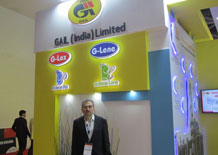PRA Chinese
Rubber Journal Asia Injection Moulding Asia Energy, Oil & Gas Asia
VISIT OUR OTHER SITES:
PRA Chinese
Rubber Journal Asia
Injection Moulding Asia
Energy, Oil & Gas Asia
Plants: Gail produces India’s first metallocene LLDPE; Ineos awards FEED contract to SK E&C

India’s gas/petrochemical firm Gail India says it successfully produced metallocene linear-low density polyethylene (mLLDPE) on its world-class 400,000-tonne/year Unipol PE Reactor line located in Pata, Uttar Pradesh, early this year.
B.C Tripathi, Chairman/Managing Director of Gail commented that demand for metallocene PE resins provides significant growth opportunities within the Indian PE market, particularly for higher-end applications that require metallocene's film performance attributes, rather than conventional PE resins.
He also added, “This move of Gail shall promote "Make in India" and shall help potential forex savings of over US$100 million annually for India, as per initial estimates."
Gail adds that its G-Lene metallocene LLDPE resin products are well-suited for a wide-range of metallocene-based film structures that require advantaged performance - particularly important for applications such as stretch wrap films, agricultural films and food packaging films.

Meanwhile, in other news, Ineos has awarded the FEED contract for its PDH (propane dehydrogenation unit) at the centre of its EUR3 billion investment to be located at its Antwerp site in Belgium, to South Korea’s SK E&C
The 750,000 tonne/year-plant is due to come on stream in 2023.
John McNally, CEO Ineos Project One said: “The selection of SK E&C is a significant step-forward for the development of the project. Our decision is based on a thorough and rigorous assessment of the needs of the project and the expertise of the companies capable of designing state of the art, reliable and efficient PDH units. SK E&C are best placed to help us to apply leading edge technology to the design of a reliable PDH facility.”
The PDH process produces propylene by removing hydrogen from propane gas. The main use for propylene is PP, which is increasingly used in components to make cars lighter and more efficient. It is also used to produce acrylonitrile without which there would be no carbon fibre, which is increasingly important for transport, and for acrylic fibres for clothing. Propylene oxide which is also based on propylene is used in insulation foams for construction. The efficient production of hydrogen as a by-product is increasingly becoming a product of interest for future zero carbon fuel and energy systems for transportation.
(PRA)Subscribe to Get the Latest Updates from PRA Please click here
©2018 Plastics and Rubber Asia. All rights reserved.

©2018 Plastics and Rubber Asia. All rights reserved.
Home Terms & Conditions Privacy Policy Webmail Site Map About Us



















